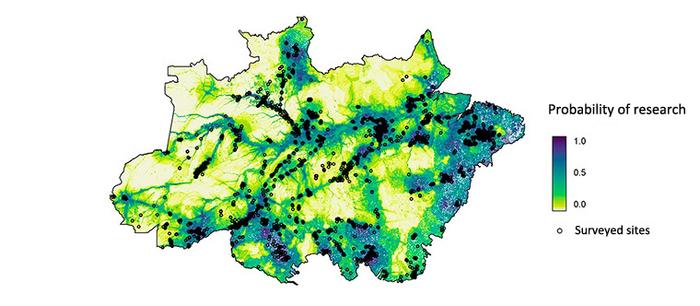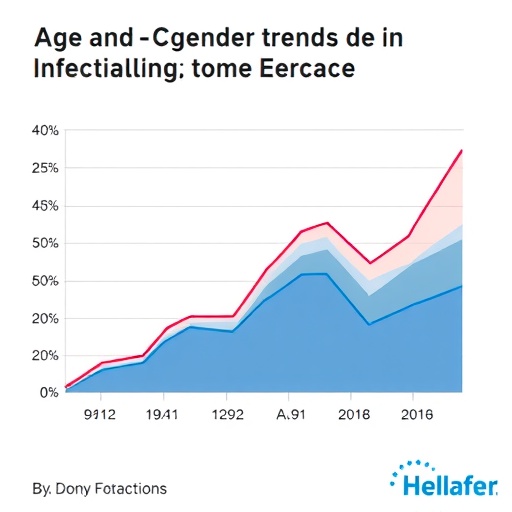Many parts of the Brazilian Amazon are neglected in ecological research, for several reasons, according to an article published in the journal Current Biology. Authored by Joice Ferreira of the Federal University of Pará (UFP) and colleagues from many countries who also belong to the Synergize Consortium, the article identifies the areas missing from ecological research and the factors that have determined these gaps, pinpointing opportunities for the planning of new investments in research in the region.

Credit: Alexander Lees
Many parts of the Brazilian Amazon are neglected in ecological research, for several reasons, according to an article published in the journal Current Biology. Authored by Joice Ferreira of the Federal University of Pará (UFP) and colleagues from many countries who also belong to the Synergize Consortium, the article identifies the areas missing from ecological research and the factors that have determined these gaps, pinpointing opportunities for the planning of new investments in research in the region.
The researchers analyzed data from 7,694 ecological research sites to try to understand how logistics and human influence on the forests could explain the probability of research being done in different parts of the Amazon region. The period analyzed was 2010-20, and the survey covered nine groups of organisms: benthic invertebrates (living on the seabed or in the lowest layers of any water body), heteropterans (true bugs), odonates (dragonflies and damselflies), fish, macrophytes (aquatic plants), birds, woody vegetation, ants, and dung beetles.
“The consortium contacted people who had contributed to databases, standardized inventories and studies involving sampling efforts. Information was thereby compiled on three groups that represent Amazonian biodiversity: vertebrates, invertebrates, and plants in upland forests, flooded forests and aquatic environments – rivers, lakes, etc. This is the first paper published by the group,” said Mario Ribeiro de Moura, a researcher at the State University of Campinas’s Institute of Biology (IB-UNICAMP) in São Paulo, Brazil. He is a co-author of the article and a member of the consortium.
The findings evidenced high susceptibility to climate change by 2050 in 15%-18% of the most neglected areas in the Brazilian Amazon. The least studied areas are also the most threatened in the vicinity of the “deforestation arc”, a swathe of territory extending along the southern, southeastern and eastern borders of Amazonia, mostly in the states of Acre, Amazonas, Maranhão, Mato Grosso, Pará, Rondônia and Tocantins.
The main gaps in Amazonian ecological research were in upland areas. “This was expected and probably reflects the role played by navigable waterways in facilitating access to blackwater and whitewater inundation forest, as well as other aquatic environments,” Moura said.
Not by chance, the least pessimistic scenarios appeared along rivers in northeast Pará and Roraima, southeastern Acre and northern Rondônia. “In these areas, the future impact of climate change will be less severe, and we have more knowledge of the species that live there,” Moura said.
The study was supported by FAPESP via two postdoctoral fellowships in Brazil. One of the fellowships was awarded to Raquel de Carvalho, and the other to Angélica Faria de Resende. Moura was supported by a Young Investigator Grant and a scholarship in Brazil.
Research biases
The scientists mapped the most neglected areas of the Amazon region in terms of ecological research and superimposed on this map the areas most likely to be affected by climate change based on a metric they developed to reflect its intensity. Deforestation and degradation data were taken from a recent study published in Science on the drivers of deforestation in the Amazon. The correlations between datasets showed that ecological research in the Amazon is more frequent in deforested areas than areas where deforestation is predicted in the next three decades.
“Environmental change is happening at a very fast pace, including climate change and landscape transformation. To understand how these changes affect biodiversity, we need to know what was in a given area before they happened. The Amazon is one of the last significantly conserved refuges of tropical biodiversity and essential to an understanding of the isolated effect of climate change and habitat destruction on biodiversity,” Moura said. “The study highlighted the areas at risk of environmental change in the coming years and not yet explored by scientists. Without sufficient ecological research, we won’t be able to know what’s changing and what’s being lost.”
With regard to logistics, accessibility and distance to research facilities were key predictors of the probability of research being done. “Access is a mixed blessing, as evidenced by the deforestation arc. Easy access enables researchers to reach more areas, so part of this immense arc has been thoroughly studied, but it also enables those responsible for deforestation and other malefactors to reach these areas. Little information is available on the threatened areas at the edges of the deforestation arc,” Moura said.
Access, and hence research probability, increased with proximity to transportation and research facilities for all upland organisms and most representatives of wetlands and aquatic habitats. “The length of the dry season determines ease of access by water. In flooded forest areas, the shorter the dry season, the easier it is to gain access by river, and this increases the likelihood of research. In upland areas, more severe dry seasons facilitate overland access, with less mud and inundation,” Moura said.
Forest degradation and land tenure were also moderately effective predictors, albeit with consistent importance, across all organism groups. Both factors affected ecological research in the same direction, with research probability slightly declining in more degraded areas and Indigenous territories, but increasing in conservation units.
In short, less research is done in degraded areas and Indigenous territories, and more in conservation units. “It’s harder to obtain access to Indigenous communities, or there may be a lack of administrative mechanisms that connect researchers with the bodies that regulate such access and with the communities themselves. We need to improve integration between the parties involved, and above all engage local communities in the knowledge creation process. Far more research goes on in conservation units than Indigenous territories, although both are types of protected area,” Moura said.
In Carvalho’s opinion, this is a distribution problem, since Indigenous territories account for some 23% of the total area of the Brazilian Amazon. “At the same time, several Indigenous territories are the best conserved parts of the Amazon biome. It would be very valuable if we could do research there,” she said.
Novel strategies
According to Moura, the Amazon Rainforest is under-represented in global databases used as a source for research on biodiversity. “As noted in the article, we need to integrate the information we have about the Amazon with global databases. The Synergize Consortium has projects that could contribute to global assessments. The information reviewed for this study mostly complies with the requirements of other databases and could be used to improve the representativeness of Amazonian biodiversity in future research on global change. The consortium plans to use this study as a basis for establishing itself as an important collaborative network for other research groups interested in analyzing environmental changes in the Amazon,” he said.
The Synergize Consortium’s principal investigators are Ferreira, who is affiliated with EMBRAPA Amazônia Oriental, a unit of the Brazilian Agricultural Research Corporation (EMBRAPA); and Filipe França, a researcher at the University of Bristol in the United Kingdom. Jos Barlow, a professor at the University of Lancaster, also in the UK, is a co-author of the article and a member of the consortium’s steering committee.
Moura believes the group’s findings can be used to develop novel funding strategies for the Amazon. “Once you’ve identified the gaps, you can target them for investment in conservation and research, or give more weight to research in these areas in future calls for proposals. Public policy and action plans can take these results into consideration, especially as far as biodiversity monitoring and inventorying are concerned,” he said.
About São Paulo Research Foundation (FAPESP)
The São Paulo Research Foundation (FAPESP) is a public institution with the mission of supporting scientific research in all fields of knowledge by awarding scholarships, fellowships and grants to investigators linked with higher education and research institutions in the State of São Paulo, Brazil. FAPESP is aware that the very best research can only be done by working with the best researchers internationally. Therefore, it has established partnerships with funding agencies, higher education, private companies, and research organizations in other countries known for the quality of their research and has been encouraging scientists funded by its grants to further develop their international collaboration. You can learn more about FAPESP at www.fapesp.br/en and visit FAPESP news agency at www.agencia.fapesp.br/en to keep updated with the latest scientific breakthroughs FAPESP helps achieve through its many programs, awards and research centers. You may also subscribe to FAPESP news agency at http://agencia.fapesp.br/subscribe.
Journal
Current Biology
DOI
10.1016/j.cub.2023.06.077
Article Title
Pervasive gaps in Amazonian ecological research
Article Publication Date
19-Jul-2023




